|
Collect Vintage Cufflinks
and Collect Anything & Everything
| By David Hrobowski
Posted November 2013
|
 |
|
Do you know—no matter what you collect, there is more than likely a related cufflink? Historical, paperweights, bisque, Limoges, gems, games, enamels, photos, designers, events, wars and battles, politics, buttons, famous people and personalities, coins, TV shows, airlines, menuki (ornaments on the handles of Japanese swords), organizations, cars, musical instruments, watches, fast food restaurants, company icons, religion, artists, plastics, pillboxes, liquors and spirits, schools, occupations, military, cameos, space and technology, intaglios, novelties, art glass, globes, miniatures, gambling and casinos, Native American, advertising, animals, sports, Mexican silversmiths, sea gems, sculptures, porcelain, musical groups, monuments and the list goes on and on. I feel vintage cufflinks are one of the last collecting frontiers.
Cufflinks were born with the demise of laced sleeves and ribbons. As the fancy lace on sleeves diminished, something was needed to dress up the cuff. Enter stage right, the cufflink, circa 1650. Initially, these cuff ornaments were made of silver or gold supporting faceted paste or gems of clear quartz; some were even crowned with semi-precious gemstones. These accessories of a gentleman's wardrobe were only worn by wealthy men or those of nobility. It would take a little over 200 years before they would be enjoyed by the masses.
|
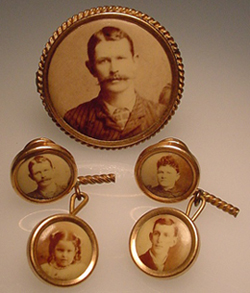
Family photo cufflinks, gold plated, but
there are solid gold examples. The photos can be sepia tone, black & white, or hand tinted and date as far back as ca. 1900.
|
During the 17th century, crude miniature painted portraits, simple designs of twisted gold wire and enameled metal—all secured behind rock crystal or glass—were the fashion. After the execution of King Charles I in 1649, rock crystal jewels referred to as "Stuart Crystals" made their debut and some as cufflinks. Stuart Crystals got their name from the House of Stuart, which was a European royal house. These crystals frequently were political in nature, such as the commemoration of the execution of King Charles I in 1649.
| 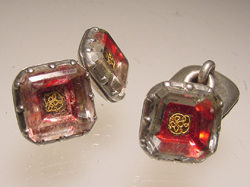
|
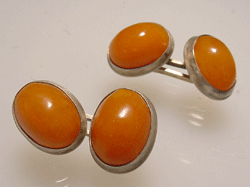
|
| Stuart Crystal cufflinks are faceted rock crystal quartz with gold wire ciphers. They were produced in support of the monarchy after the execution of King Charles I in 1649.
|
Double-sided cufflinks are the oldest type
of cufflink and are still used today.
|
There were also colonial cufflinks from this time period, and they have their own story. Both Stuart Crystals and the colonial links of that time were all double-sided cufflinks, and I believe they are the oldest of all the cufflinks. Amazingly, this simple design is still being used today, over 300 years later. Although there have been many innovative cufflink closing mechanisms over the years, the toggle cufflink that most people are familiar with was an invention of the late 1930s and early 1940s.
Until the Internet, there was no venue to really expose the vast diversity of cufflinks. Although, there have been noteworthy cufflink collections built over the years, they have been isolated, limited, very specific and without broad organization or contrast, until now.
Cufflinks can be found in the usual places like flea markets, garage sales, pawn shops, and thrift stores. Searching the Internet is all about the search techniques. For example, searching for misspelled words like “cuflink” or “kufflink,” “safire” or “saphire” (for sapphire) can yield some interesting results. In the early days of the Internet, these little tricks worked better than today because now many search programs will automatically correct misspelled words. When choices are offered, check them all out.
| 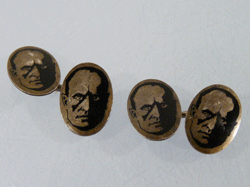
|

|
| Benito Mussolini, the only such cufflinks
the
author has seen; sterling and enamel,
ca. 1930.
|
Scissor, knife and file cufflinks and tie bar,
chrome plate, ca. 1950, Italian.
|
Sometimes, vintage or antique cufflinks are listed in the wrong category on auction sites; for example, a 14k gold cufflink will be included in the costume jewelry category or an antique link in the contemporary category. This oversight can be your blessing.
Occasionally, a very collectable link like a hand-painted Toshikane, a solid gold Larter or a Danish modern Hans Hansen, will be listed as plastic, gold-filled or just sterling, respectively, because the person does not recognize the hallmarks. Again, this could be a blessing for you.
A few tips for anyone who wants to build a vintage cufflink collection:
1. Get a jeweler’s loupe. I suggest a 10x power single lens loupe, unless you plan to collect gemstones. The loupe will assist you in viewing detail, condition, hallmarks and markings, and it will aid in determining the substances from which the links are made.
2. Think now about storage and/or display, photographing and cataloging. I learned about the photographing and cataloging after I accumulated more than 10,000 pairs. It took a year and a half to catch up when all this could have been done at the time of purchase and with very little effort.
3. Set boundaries as to what kinds of cufflinks you like, even though these will more than likely change over time and be plagued with exceptions. In my opinion, setting no boundaries may yield a collection of more than 10,000 pairs and may strain your finances and relationships.
4. Familiarize yourself with the terms and definitions of the trade. Because you will be in the world of jewelry, it is important to understand the basic nomenclature.
Purity of precious metals: platinum = 0.90 and 0.950 (90% to 95% pure); palladium = 0.950 (95%); gold, 24k = 0.995 (99.5%), 22k = 0.917 (91.7%), 18k = 0.750 (75%), 14k = 0.585 (58.5%), 10k = 0.417 (41.7%), 9k = 0.375 (37.5%), and 8k = 0.333 (33.3%); and silver = 0.925 (sterling), although 0.980, 0.835 and 0.800 all have been used in making cufflinks with .980 being used by many well-known Mexican silversmiths and .835 and .800 being used by many European silversmiths.
| 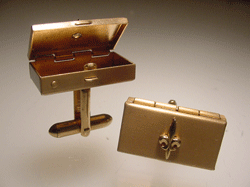
|
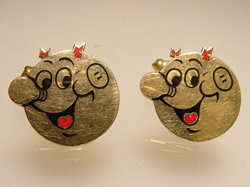
|
| Functional pillboxes, gold tone, ca. 1950;
examples in sterling and gold exist.
|
Reddy Kilowatt, gold tone and
reverse-painted glass intaglio; solid gold
examples exist.
|
Nomenclature: Gold plate, gold filled, rolled gold, rhodium plated, decal, mosaic, inlay, cabochon, guilloche, cultured pearl, faceted, faux, pseudo, machine tooled, repousse, incised, appliqué, cameo, intaglio, reverse painted, millefiori, celluloid, Bakelite, bisque, pique, karat clad, gilt, niello, die cast, scrimshaw, pitting, corrosion, etc.
Popular designers and companies: Swank, Tiffany, Anson, Cartier, Toshikane, Allan Adler, Hans Hansen, David Webb, Steuben, Trifari, Hattie Carnegie, Krementz, Correct Quality, Michael Michaud, Fenwick & Sailor, Victoria Flemming, David Andersen, Ed Harris, Esther Lewittes, Coro, Sarah Coventry, William Spratling, Margo de Taxco, Antionio Pineda, Hogan Bolas, Delft, Royal Copenhagen, Mikimoto, Wedgwood, Ruskin, Weiss, Hermes, Just, Russer, Cini, Wallace and Los Castillo.
Eras: Contemporary (1970 to present), Mid-Century (1940s & ‘50s), Deco (1920s), Arts & Crafts (1910 to 1920), Edwardian (1901 to 1910), Nouveau (1890 to 1910), Victorian (1837 to 1901), Georgian (1740 to 1830) and finally the mother of all cufflinks, Antique (1650 to 1830), although the standard definition is anything over 100 years of age.
Closing mechanisms: Double-sided cufflinks, which are the oldest cufflinks and continue to be made; single-sided links (ca. 1900 to present); ball backs and bean backs (ca. 1900); barbell links (1920 to present); button backs or cuff buttons (1880 to 1900); snap links (1915 to 1930), wrap-a-rounds and toggles (1940s to present).
| 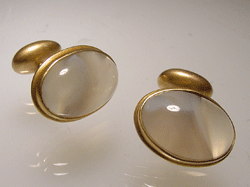
|
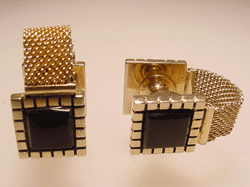
|
| A bean back cufflink closing mechanism
used ca 1900.
|
Wrap-a-round cufflinks are toggle or
snap cufflinks
with a mesh or solid band
that wraps around the
cuff from front to
back.
|
Cufflink converts: These are cufflinks made from existing items—buttons, earrings, coins, arrows, watch movements, lapel pins, etc. This type of cufflink is very tricky because their quality and value are directly related to their maker's aesthetic and expertise.
Extremely rare, vintage cufflinks: Unlike the National Button Society which was organized in 1938 and has had years to determine what is truly rare, vintage cufflinks will need time before accurate forecasts can be made. In the meantime, here are a few rare cufflinks to look for: Alfred E. Newman Mad magazine cufflinks, Trifari enamel animals, 18th century Essex crystal, 18th century paste, tri-color Wedgwood, Hit Parade (the precursor to American Bandstand) and Steuben.
| 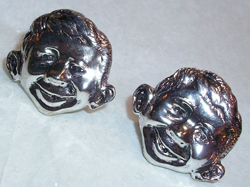
|
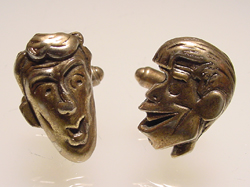
|
| Extremely rare: Alfred E. Newman,
advertised in the 1957 Mad Magazine
issue #33. They originally sold for $3 per
pair. In Oct. 2000, a pair with matching
tie bar in original shipping box sold on
eBay for $2,709.
|
Rare: Sterling silver Dean Martin and Jerry
Lewis
cufflinks. Caution: sterling
reproductions have been
made; the
originals have pivoting toggles and the
copies have fixed or stationary toggles.
|
Rare, vintage cufflinks: Ed Harris, Lewittes, Beatles, Woodstock, large figural Toshikane faces, Fornacetti and paperweight links by St. Louie, Perthshire and Caithness.
Reproduction cufflinks. Frequently, vintage links that are rare or have been very popular in the past are reproduced, such as the figural Alfred E. Newman face cufflinks, the 1955 Marilyn Monroe reverse-painted nudes and the quartz Essex crystals. Although the revised versions share the same subject matter, they are not the same. As with all reproductions, the technology of the time, availability of the materials and the cost of production dictate the end results. Often, exact duplication is both cost and labor inhibitive. In any era, there only exists what was made and what has survived; that's it.
Occasionally, a reproduction is so close to the original that differentiation is more difficult, and the only thing separating the two is expertise. When collecting vintage cufflinks, the links that first introduced the concept, the style, the material or the commemoration of an event is the one to seek.
Modified cufflinks. In reference to modifications, it is my belief the further away from the original manufactured state a vintage cufflink is, the less value it retains. However, I have from time to time paid good money for partial pairs, damaged pairs and pairs that have been converted to more contemporary closing mechanisms, but this has always been based on rarity, for example: a single 18th century Stuart crystal cufflink, a cracked tri-color Wedgwood link or a Victorian cuff button that has been aesthetically modified to a toggle link. The bottom line is, these are all individual calls to be made by the collector.
| 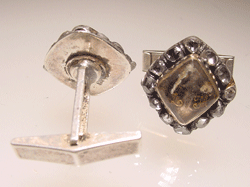
|
These silver, quartz and rose-cut diamond
cufflinks are modified, or recreated, from
a pair of earrings, necklace fragments or a
lone cufflink.
|
The more you know about the cuff links you search for and the more cufflinks you examine closely (even if you don't purchase them), the better equipped you are to reap the benefits of common listing or presentation mistakes. Just as not all cufflinks that are stamped with a karat mark are gold, links with punchmarks or no marks can be unmarked precious metals. This is where a trained eye and experience will prevail!
EBay is the premier auction site for bidding on vintage cufflinks, whereas Etsy, Ruby Lane, Amazon, 1stdibs and private sites have fixed prices. This is not to say that great deals cannot be found on fixed priced sites, but one must know one's stuff to excel. Because non-precious vintage links like the big names of Tiffany, Cartier, David Webb and others are not normally found front and center in shops, it is important to ask the seller, dealer or shop owner if they have vintage cufflinks, as this may lead to a really great find.
My suggestion is to leave no stone unturned in your quest to find unique and distinctive vintage cufflinks since collecting them is still in its neonatal stages. Good deals and rare links are still being found, although the pond seems to be slowly drying up.
There is much more that could be said, but for now, stake your claim and be a pioneer in the growing field of vintage cufflink collecting.
Oh, I almost forgot—there is the collectable world of tie bars, tie tacks and money clips.
------------------------------------
David Hrobowski, aka The Cufflinkking, became intrigued with cufflinks when he purchased his first pair in 1979 for $4, and he has been collecting them ever since. His website is www.cufflinkking.com, and he sells cufflinks on eBay under the seller name of cufflinkking*. To contact him, call 310 975-5570 or email cufflinks@earthlink.net.
A glossary of cufflink terms and photos may be viewed at www.cufflinkking.com/glossary.htm.
|